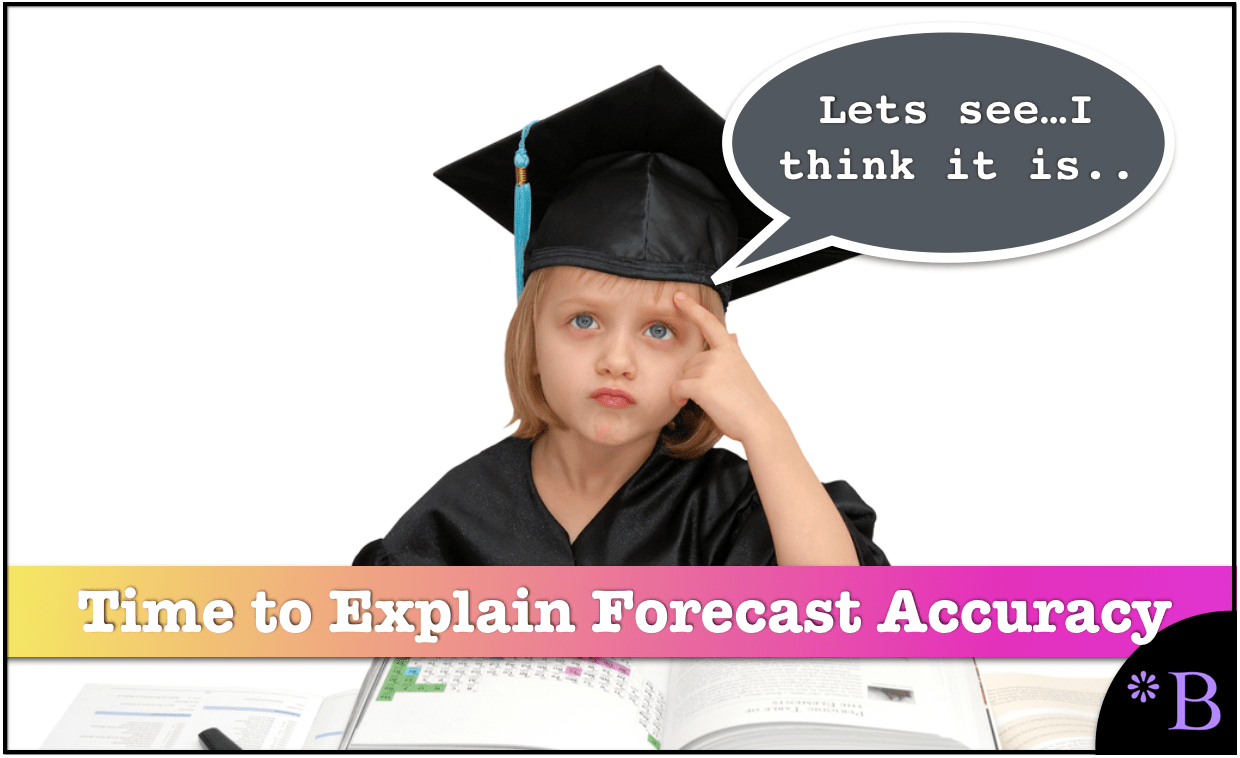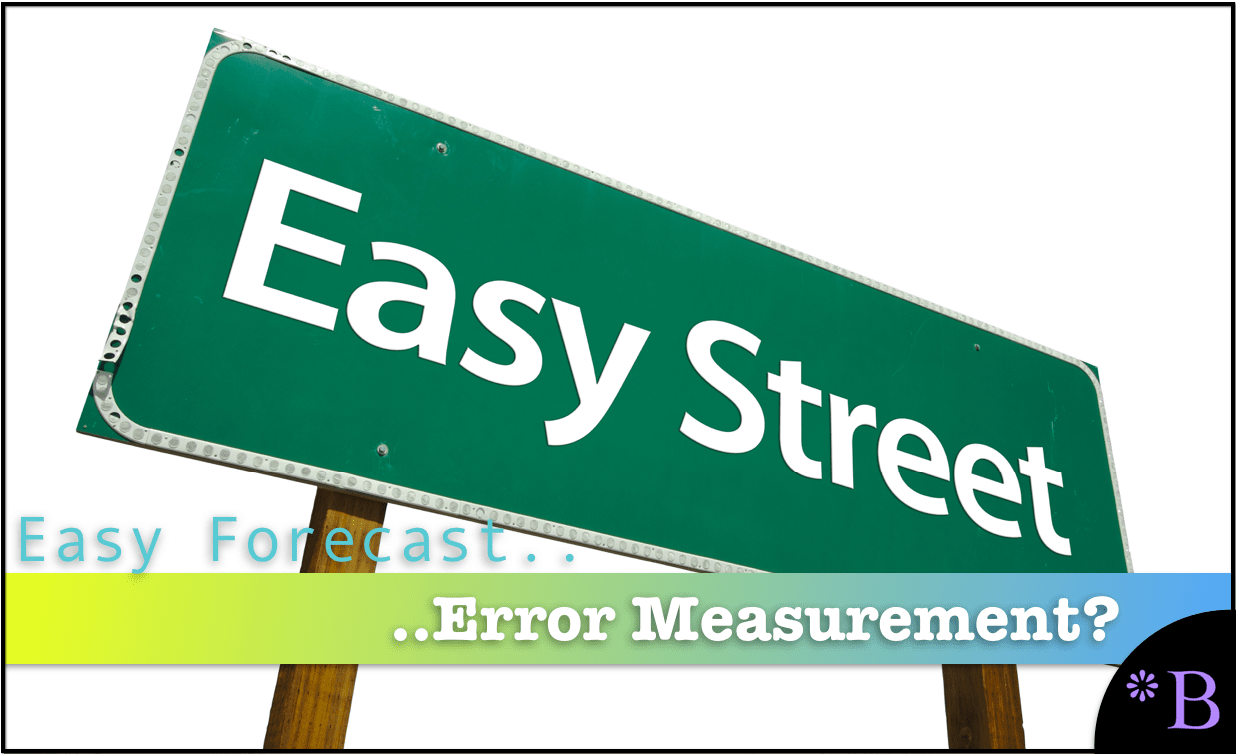How Do You Explain Forecast Accuracy?
Executive Summary
- Being able to explain forecast accuracy is essential to getting people to consider forecast accuracy important.
- We cover the most basic way to explain forecast accuracy.

Video Introduction: How Do You Explain Forecast Accuracy?
Text Introduction (Skip if You Watched the Video)
The question of how do you explain forecast accuracy is a pervasive one. Forecast error is deceptively easy to understand and leads people in the future with the concept for decades without understanding the details. This is because the details of forecast accuracy are rarely discussed. We have found that the vast majority of people who work with forecast errors can often be caught off guard about their forecast error, such as what dimensions and context apply to the error calculation. This problem with understanding forecast error restricts the ability to improve the accuracy of the forecast.
Our References for This Article
If you want to see our references for this article and related Brightwork articles, see this link.
Forecast Error Myth #6: Forecast Error Measurements are Straightforward to Do
We consider this one of the significant myths of forecasting. For a forecast error measurement to be understood, it must be documented in full. Not only must the forecast error method be explained, but all the related factors, ranging from the forecast planning bucket to the level of aggregation reported, must be understood.
All of this is to get a person to just a basic understanding of the forecast error.
For All of the Myths, See the Following Table
Forecasting Error Myths
| Myth Number | Forecasting Error Myth | Forecasting Error Myth Article and Link |
|---|---|---|
| 1 | One Can Rely on The Forecast Error Measurement in Forecasting Applications | Link |
| 2 | Unweighted Forecast Error Measurement Makes Sense | Link |
| 3 | Sales And Marketing Have their Forecast Error Measured | Link |
| 4 | Most Forecast Error Measurement Supports Identifying How to Improve Forecast Accuracy | Link |
| 5 | Non Comparative Forecast Error Measurement is Helpful | Link |
| 6 | Forecast Error Measurements are Straightforward to Do | Link |
The Problem of Stopping Too Early on Forecast Error Explanation
A significant issue is assuming that groups that do not calculate the forecast error themselves are aware of what the forecast error means. We argue that a forecast error that is not comparative has little utility, as we cover in the article Forecast Error Myth #5: Non Comparative Forecast Error Measurement is Helpful.
This is not a view shared by most — even experienced people that work in forecasting. Yet we came to this conclusion independently after working in forecasting for over a decade and being exposed to how forecast error measurement is performed at many companies.
- Our conclusion is further that the only forecast error measurement that is valuable naturally tells the people working in forecasting where to put their effort to improve forecast accuracy.
- A forecast error without context does not drive the people responsible for forecasting to improve accuracy.
- The worst situation is not to measure forecast error at all.
- However, a quick second is not knowing where to focus once the forecast error is determined.
Explaining Forecast Accuracy
How do you explain forecast accuracy means understanding the forecast accuracy yourself. There are far more people quoting forecast accuracy and discussing forecast accuracy than understanding it in all of its dimensions.
At the highest level, forecast accuracy is a difference between the forecast and the actuals. But there are frequently several questions about even these numbers.
- Defining the Forecast: For the forecast, was this the forecast before lead time, or were changes made within lead time doing something like demand sensing? For a forecast accuracy measurement to be useful, it must not be altered after the time to respond to the forecast has passed.
- Defining the Actuals: For the actuals, the number that was sold or the number could have been sold if capacity has been available. However, authentic demand is not what was provided, which is a constrained demand. We cover this topic in the article How to Best Understand Measuring the Unconstrained Forecast.
All forecasting error calculation is some derivation of the distinction between forecast and actuals. However, explaining forecast accuracy is that the most common forecast error measurements don’t lead themselves to easy explanation. Unless a person is frequently dealing with forecast error calculation, it is easy to forget the definition of the forecast error measurements.
Remembering the Dimensions of the Forecast Error
A forecast error deprived of its context is not useful. The level of aggregation, the planning bucket, and a host of other factors are necessary for explaining the forecast accuracy.
All of this is why we recommend staying away from complex forecast error measurements.
A More Straightforward Approach to Forecast Error Calculation
Observing ineffective and non-comparative forecast error measurements at so many companies, we developed the Brightwork Explorer in part to having a purpose-built application that can measure any forecast and compare this one forecast versus another.
The application has a very straightforward file format where your company’s data can be entered, and the forecast error calculation is exceptionally straightforward. Any forecast can be measured against the baseline statistical forecast — and then the product location combinations can be sorted to show which product locations lost or gain forecast accuracy from other forecasts.
This is the fastest and most accurate way of measuring multiple forecasts that we have seen.
Why Do the Standard Forecast Error Calculations Make Forecast Improvement So Complicated and Difficult?
It is important to understand forecasting error, but the problem is that the standard forecast error calculation methods do not provide this good understanding. In part, they don't let tell companies that forecast how to make improvements. If the standard forecast measurement calculations did, it would be far more straightforward and companies would have a far easier time performing forecast error measurement calculation.
What the Forecast Error Calculation and System Should Be Able to Do
One would be able to for example:
- Measure forecast error
- Compare forecast error (For all the forecasts at the company)
- To sort the product location combinations based on which product locations lost or gained forecast accuracy from other forecasts.
- To be able to measure any forecast against the baseline statistical forecast.
- To weigh the forecast error (so progress for the overall product database can be tracked)
 Getting to a Better Forecast Error Measurement Capability
Getting to a Better Forecast Error Measurement Capability
A primary reason these things can not be accomplished with the standard forecast error measurements is that they are unnecessarily complicated, and forecasting applications that companies buy are focused on generating forecasts, not on measuring forecast error outside of one product location combination at a time. After observing ineffective and non-comparative forecast error measurements at so many companies, we developed, in part, a purpose-built forecast error application called the Brightwork Explorer to meet these requirements.
Few companies will ever use our Brightwork Explorer or have us use it for them. However, the lessons from the approach followed in requirements development for forecast error measurement are important for anyone who wants to improve forecast accuracy.